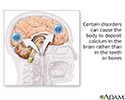Calcification
Calcification is a process in which calcium builds up in body tissue, causing the tissue to harden. This can be a normal or abnormal process.
Information
Ninety-nine percent of calcium entering the body is deposited in bones and teeth. The remaining calcium dissolves in the blood.
When a disorder affects the balance between calcium and certain chemicals in the body, calcium can be deposited in other parts of the body, such as the arteries, kidneys, lungs, and brain. Calcium deposits can cause problems with how these blood vessels and organs work. Calcifications can usually be seen on x-rays . A common example is calcium depositing in the arteries as part of atherosclerosis.
x-rays
X-rays are a type of electromagnetic radiation, just like visible light. An x-ray machine sends individual x-ray particles through the body. The im...

References
Horvai A. Bones, joints, and soft tissue tumors. In: Kumar V, Abbas AK, Aster JC, eds. Robbins and Cotran Pathologic Basis of Disease . 9th ed. Philadelphia, PA: Elsevier Saunders; 2015:chap 26.
Kumar V, Abbas AK, Aster JC. Cellular responses to stress and toxic insults: adaptation, injury, and death. In: Kumar V, Abbas AK, Aster JC, eds. Robbins and Cotran Pathologic Basis of Disease . 9th ed. Philadelphia, PA: Elsevier Saunders; 2015:chap 2.
-
Cranial calcification - illustration
Cranial calcification is a disorder in which calcium that enters the body, which is usually absorbed by the bones and teeth, is deposited in another area of the body such as the brain. Calcium deposits in the brain can cause problems in the organ and interfere with brain function.
Cranial calcification
illustration
-
Cranial calcification - illustration
Cranial calcification is a disorder in which calcium that enters the body, which is usually absorbed by the bones and teeth, is deposited in another area of the body such as the brain. Calcium deposits in the brain can cause problems in the organ and interfere with brain function.
Cranial calcification
illustration
Review Date: 7/13/2016
Reviewed By: Linda J. Vorvick, MD, Medical Director and Director of Didactic Curriculum, MEDEX Northwest Division of Physician Assistant Studies, Department of Family Medicine, UW Medicine, School of Medicine, University of Washington, Seattle, WA. Also reviewed by David Zieve, MD, MHA, Isla Ogilvie, PhD, and the A.D.A.M. Editorial team.

